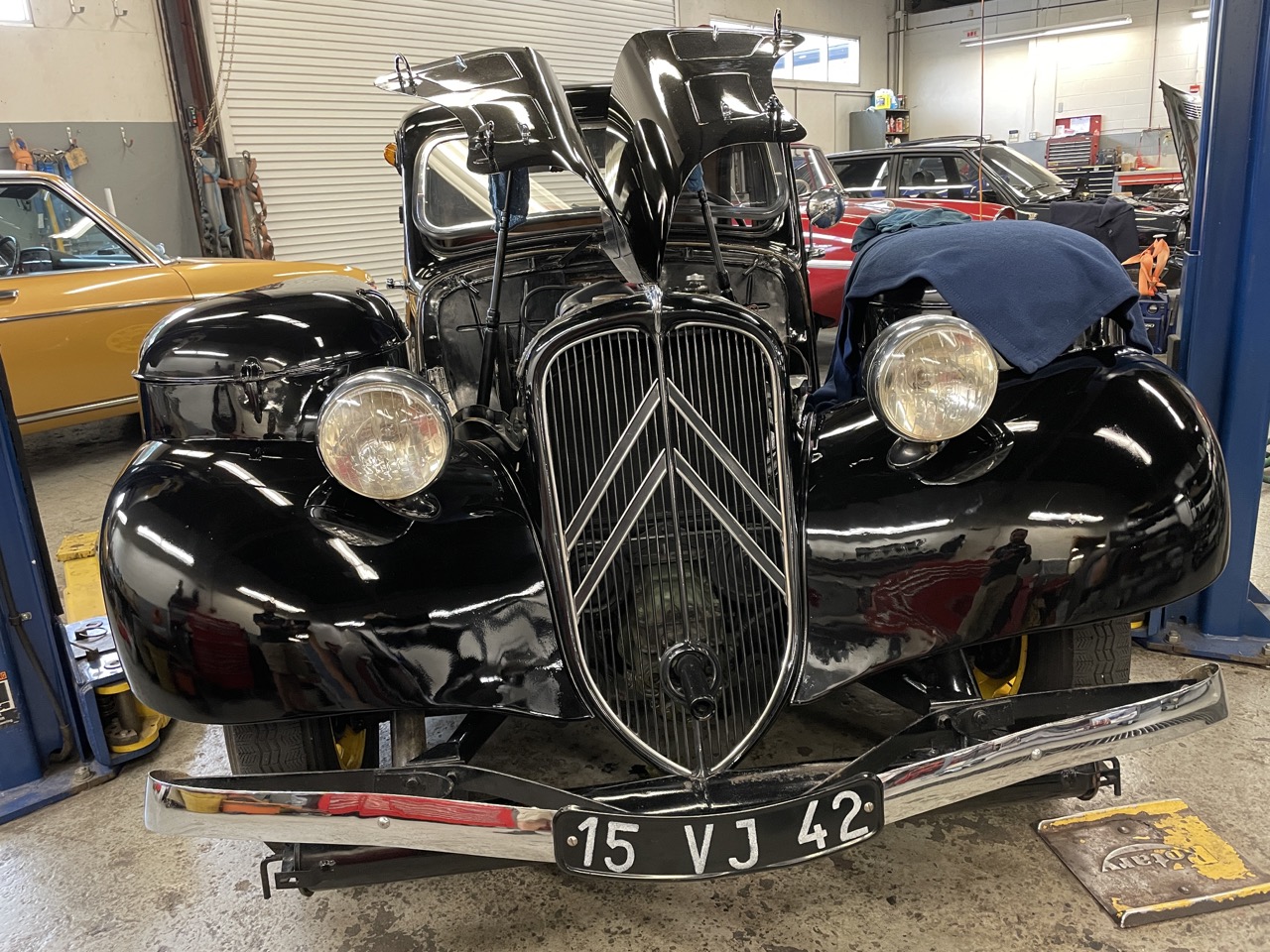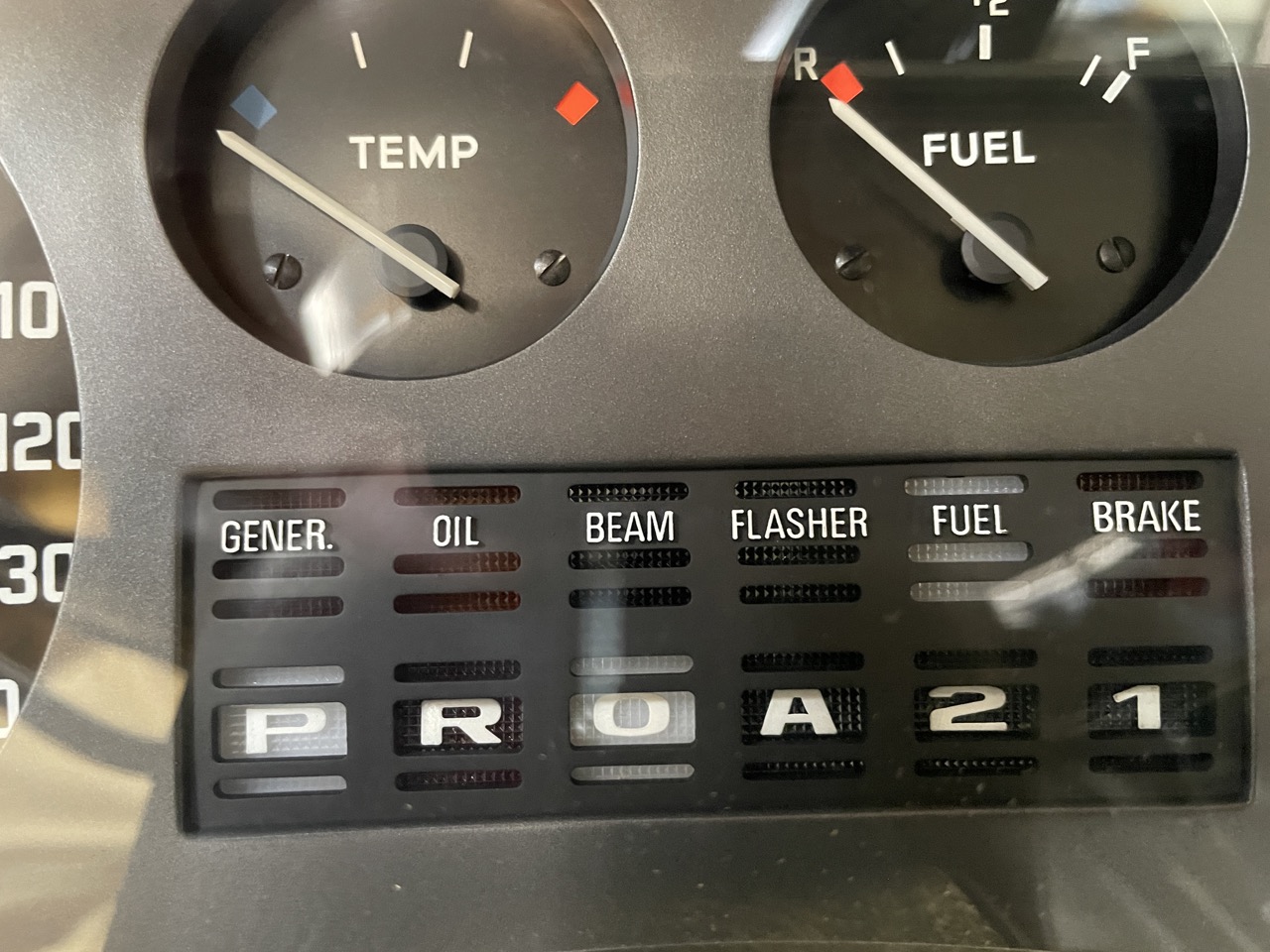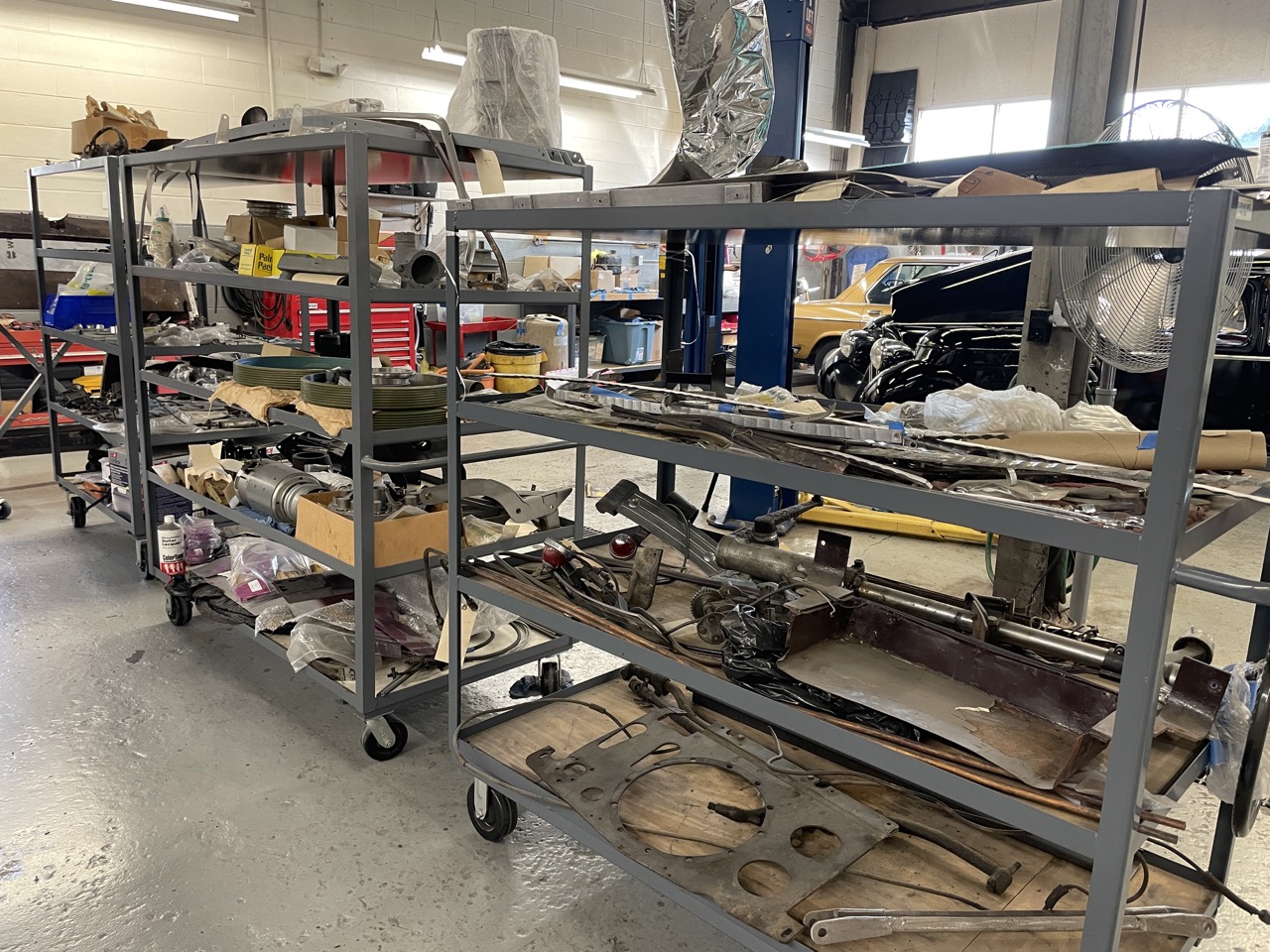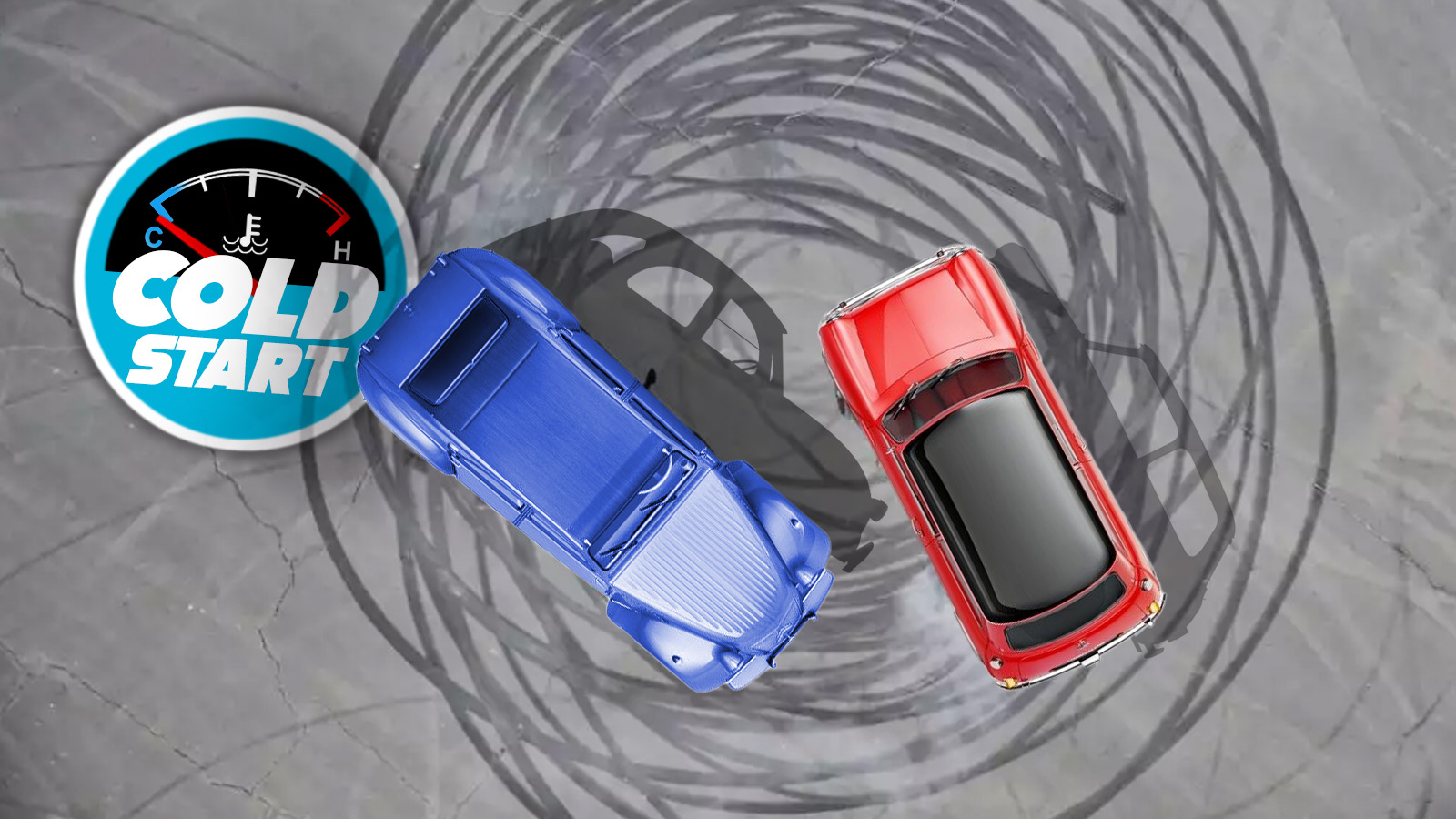Lane Motor Museum’s restoration shop is one part of the museum that isn’t really open to the public. Thankfully, the shop staff allowed me to walk around and take pictures yesterday without much grumbling. Here are the current projects we have going on.
1938 Citroen 11 Berline “Gazogene”

This Traction Avant is getting ready for the Pebble Beach Concours. The pontoons on top of the front fenders give away that this car has been modified in quite a unique way.

During the German occupation of France during World War II, gasoline was scarce, expensive, and often unavailable. Several companies offered systems for a vehicle to be powered by alternative fuels such as wood, coal, or charcoal. This particular car ran on coal.
The large cylindrical container atop the driver’s side front fender was filled with coal and ignited. In about 30 minutes, the gas (mainly carbon dioxide) would have built up in a significant volume in the main furnace, reaching temperatures of 1600-2300 Degrees Fahrenheit. That’s too hot for combustion, so the air was drawn into a condensing unit under the front bumper. The passenger-side fender unit contained a particulate filter, and the filtered, cooler air would be drawn to the top of the container, and then fed into a special carburetor, making the engine run. Using the coal system reduced horsepower by one-third, which reduced the top speed to about 45 mph (depending on how well the coal was burning). Range was about 30 miles before you had to stop and add more coal. Only a few of these conversions survive.

Our Gazogene was converted back to run on gasoline probably soon after the war, but the pontoons were kept. To get ready for Pebble Beach (the cars must be driven onto the field), Nick has done a complete service on it: oil change, fuel tank drain, new spark plugs, valve adjustment, compression test, checked and re-packed the wheel hubs, and given it an alignment. There is still a leak around the rear main seal and the rear of the oil pan, but that should be alleviated before it leaves for California.
1969 Jarret La Voiture Electronique

This little utility cart is the world’s first entirely drive-, steer-, and brake-by-wire vehicle to be produced. In the early 1960s, the Jarret brothers developed a new kind of electric motor known as a Switched Reluctance Motor. A series of 24 magnetic coils are switched in sequence to synchronize the current flow; this determines the direction of magnetism that moves a flywheel in a rotational direction.

Two SRM electric motors are directly connected to each rear wheel; the vehicle is steered by changing the relative speed of either one of the motors. The front wheel is positioned caster-style so that it moves freely in all directions, like a shopping cart. The Jarret’s narrow profile was designed to transport two people around a large factory. The original used four 12V lead acid batteries in series to deliver 48VDC to the SRM motors, but we have replaced those with lithium-ion batteries for longer range.

Only seven Jarret La Voiture Electroniques were built—two prototypes and five pre-production vehicles. Afterwards, a series of 100 Jarret Porquerolles were built but the new design had conventional DC motorization and mechanical steering, yet still used a joystick.
The shop added a larger mechanical hand brake to the Jarret juuuust in case something went screwy with the controls. Well, a couple of weeks ago, after doing a demonstration, the joystick would not respond to me telling it to go right. It just wanted to go around in circles, which I then had to utilize the hand brake a few times to keep from bumping into other cars. Once I was safely off the floor, without me touching the joystick, it started to creep to the left BY ITSELF. I maintain its haunted by one or both of the Jarret brothers. Our shop manager Greg just thinks it needs a more robust joystick. We can agree to disagree.
1990 Lancia Delta Integrale


This rally hero is also getting a general servicing, along with an A/C system rebuild and a thorough safety check.
1973 BMW Bavaria

This BMW Bavaria has a bad transmission leak, so that’s getting remedied. This proto-7 series was the only BMW model to be sold with a name instead of an alphanumeric, besides the Isetta. Also, check out the automatic transmission selector.


It goes P-R-0-A-2-1, in which the number zero is used instead of N for Neutral. Does anyone know of any other vehicle that used something other than “N” for Neutral for their automatic transmission selector? Is this some kind of German attempt at humor? Inquiring minds want to know.
1952 Gregory Roadster

Kansas City, Missouri native Ben Gregory believed that front-wheel drive was the preferred method of propelling a car. From 1920-1922, he tried to put a car into production, and it is believed that about ten were made. Funding ran out, and Gregory gave up on the car business. After WWII, he again became interested in producing a front-wheel drive car, and so the roadster seen here as well as a sedan (also in the collection) are the only cars he made. Gregory tried to convince established car manufacturers to produce his cars, but was unsuccessful. Gregory is best known for designing AMC’s Mighty Mite Jeep.

Finally back from paint, this Porsche 356-engined [Editor’s Note: Remember, this is a case where the engine is up front! – JT] American is getting its two seats repadded and upholstered:


Then all it needs is reassembly and engine testing. This is what the finished product will look like.

This chassis:

Plus this rack of parts:

Plus these racks of body panels, seats, and glass equals this:

1936 Voisin C28

This is our 1936 Voisin C28, affectionately known as Chuck. Gabriel Voisin was a major manufacturer of airplanes during World War I. In 1919, he decided to become a car manufacturer and acquired a ready-made engine design–a 3969cc sleeve-valve four which had been considered and turned down by Citroën as unsuitable for mass production. Voisin remained faithful to the sleeve-valve principle for the rest of his career as a car maker. Voisin built lightweight cars using techniques learned in his years as an aircraft designer. The Type C28 “Ambassade” body design was the last model Voisin was personally responsible for.

Chuck has been a long-term, complete nut-and-bolt restoration, but we are very close to start the rebuilding process. Its stunning upholstery proved difficult to source, the sleeve-valve engine will be difficult to restore, but man, this will be a stunner once its back to its former glory.







Avions Voisins are, in my opinion, about the prettiest cars ever made. I love how the wipers come through the glass.
In 1973 Germany you were either East or West, but never Neutral.
Insert The Simpsons “You have to put it in H” meme.
Regarding the BMW Bavaria shift nomenclature: back in the day my dad had a 1967 BMW 1800 (the Neue Klasse 4-door) automatic. It also used “0” for neutral, but the entire shift pattern pre-dated the PRNDL standard and was – front to back – “R-1-2-A-0-P”.
While it was fun to slam the shifter all the way forward to back out of the driveway, it was also easy to overshoot “A” and end up in neutral when trying to get underway.
When I did the rally for the Lane one year, I was impressed enough with their operation and the folks that worked there that I considered asking for a job _ I think I would have been a good fit as I have a wealth of weird and unusual cars experience and I do all my own wrenching. But, it would have required moving to Nashville which neither I or my wife were prepared to do. Too bad, I really liked the idea of working there…….
When restoring a car that has been modified to run coal gas before being modified back to gasoline, how do you determine the correct era of functionality to restore it to?
Why not go back to combustible superheated gasses? Coal too hard to get if you’re not a power plant?
Yes, coal availability is one thing, but the other thing is….we’re not sure how the system worked. It was converted back into a gasoline-powered car after the war, but the owners kept the pontoons. We have the special carburetor that was needed for it to run on coal, but we have no instructions or diagrams. We are all currently trying to figure out the correct schematic and explanation for a display that will go with the car, along with the special equipment, but even just explaining it has been difficult.
One day, though, once we figure it out, we will run it on coal to see what happens.
Please live-stream that day and for the love of god, keep the fire extinguishers handy.
The only acceptable driver for this would be Torchinsky, of course.
I’m not sure it’s particularly economical, but retail quantities of coal seem pretty easy to find. It’s used by coal-fired pizza restaurants as well as blacksmiths, so there’s at least a niche retail market for that kind of quantity.
I would love to have an article where we get introduced to the mechanics, and how they found the museum/you found them.
That is a good idea. I will see if the mechanics are on board.
A fantastic collection of weirdness.
I love Bavarias but would make the case that it became the 5 series. The E12 is quite similar in size and spec.
I would argue both. The E12 was a bit smaller in length and width, and replaced the lower spec E3s. The E23 replaced the later more luxurious LWB E3s like the 3.3L, having the same wheelbase and about the same length. The E3 has a lot of useful parts commonality with both cars.
I’ll also say both. I mainly was thinking of a flagship for the US market, which this was, but, yes it is much more similar in size to the E12.
Citroen 11 Berline, talk about rolling coal
I’ll see myself out
*slow claps*
That’s “O” for “Outa Gear,” right?
I adore the Voisin, I too have a thing for sleeve valve engines. The C28 was, if not the first, a very early “flying car”. John Masefield’s ‘caroplane’, driven (and flown) by the baddies in “The Box of Delights” (1935) was inspired by just such a car.
Voisins are amazing.
I hope I’m not embarrassing myself, but I had no idea what a sleeve valve engine was. I had to go give myself a crash course. It seems like it would burn a lot of oil and have some reliability issues. It also seems so very French! I love it.
Is there any pedestrian protection on the coal burning car? I assume if you touch it, you get burned…
I’m guessing in WWII France that wasn’t in the top 20 concerns.
Hopefully the only people who burned themselves on it were Gestapo.
This type of gazogene generator was not common.
The most common one consisted of two humongous tanks fixed to the top or the back or the Traction.
This one is more like plane conformal tanks in a sense which make it quite interesting.
So how many of these are actually making it to Pebble Beach this year? Hoping I’ll be able to drop by again after the pandemic break…
Oh, just the Citroen coal burner. The others are getting serviced. The Voisin will eventually make it to Pebble Beach, but not this year.